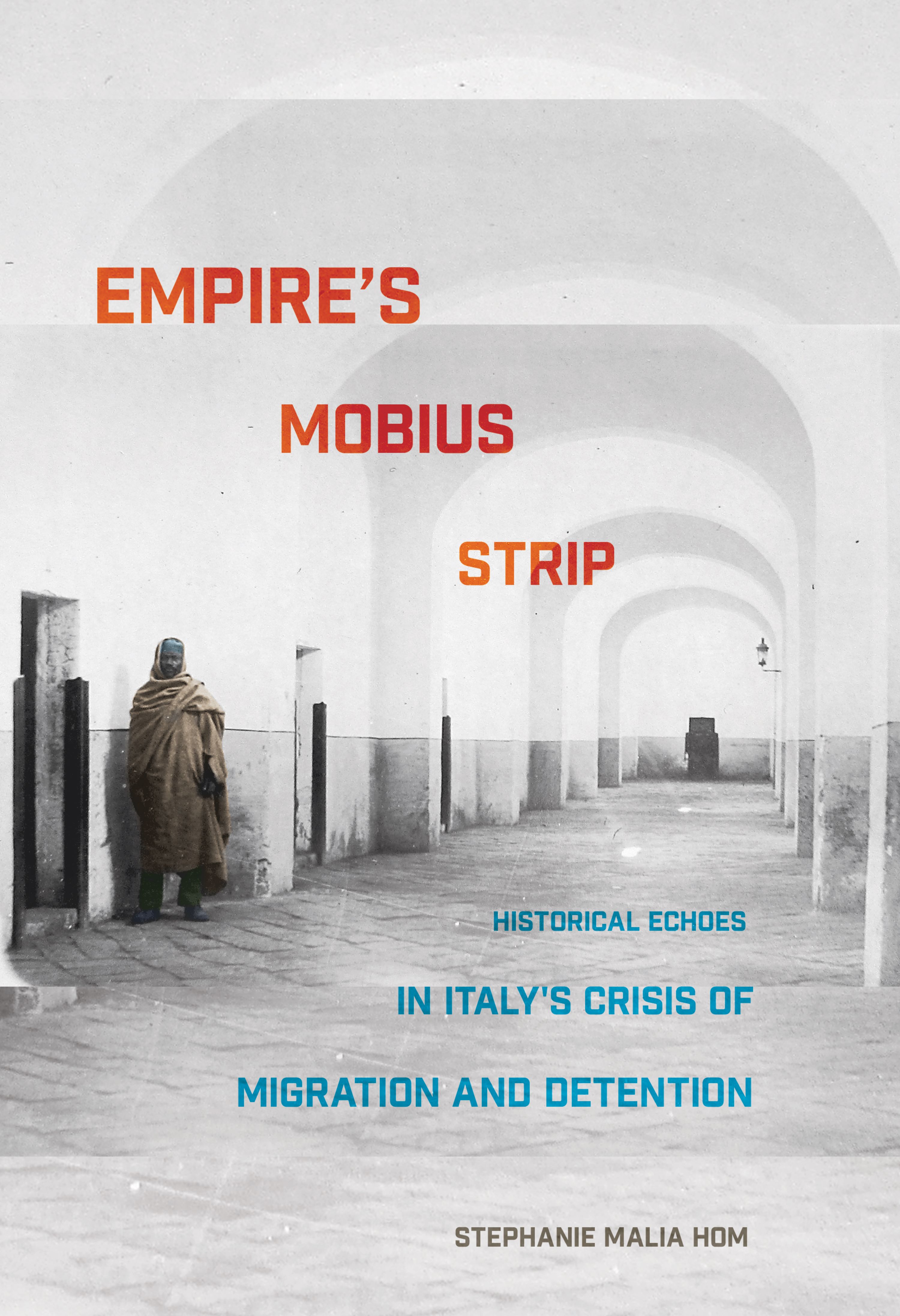
For a writer seeking to explain a complex, multifaceted issue, nothing beats a good metaphor. Stephanie Malia Hom, in her new book about Italy’s current crisis of migration and detention, uses the Mobius strip—a mathematical object that appears as an infinite loop that cannot be oriented in space or time—as the “guiding metaphor” to explore how the contemporary crisis is rooted in early twentieth-century Italian imperialism.
In Empire’s Mobius Strip: Historical Echoes in Italy’s Crisis of Migration and Detention, Malia Hom argues that Italy’s “imperial formations” and the power of empire do not “belong to a superseded era” but instead, remain with us. She says that the main way empire’s Mobius strip operates, its looping of past and present, of colonial imperialism and neoliberal empire, is through control of movement. In decades past, Italy controlled subjugated peoples by denying them the right to move from one place to another, as with the concentration camps Italian Fascism set up for nomads in Africa or the carceral islands off Italian coasts that held political prisoners. Today, the Italian state controls the movement of peoples deemed undesirable or dangerous through such sites as migrant detention centers, refugee camps, and so-called equipped villages.

In her book, Malia Hom, an anthropologist who also has worked as a journalist, draws on social theory, historical analysis, and firsthand reporting to make an original and compelling argument about an issue too often reduced to demagoguery and political point-scoring. She has visited detention centers and spoken with detainees and the lawyers and social workers assigned to work with them; delved deeply into historical archives; and gone to sites, past and present, where people whose “unsanctioned mobility” was deemed a threat to the Italian state, were confined.
The author notes that Italian empire wasn’t conceived “out of some grand lust for power or shrewd geopolitical wrangling or nostalgia to re-create the Roman empire” but rather out of “the very pragmatic fear” that the new Italian nation-state created in 1861 would lose much of its population through emigration. Italy, post-unification, was bankrupt and millions were leaving, particularly from the southern regions. “From the outset, Italy’s imperial power was predicated on the control of mobility,” Malia Hom observes. Italian empire, she notes, was short-lived, lasting from 1890 to 1943. During that half-century, Italy occupied Eritrea, Libya, Somalia, Ethiopia, and Albania, as well as a “small concession” in China and Rhodes and the Dodecanese Islands in Greece.
Despite its brief existence, Italian empire was brutal, even genocidal, which the myth of Italians as brava gente, good colonizers, has obscured. The myth, she says, has helped to repress “deeds so painful, such as the genocide of Bedouin in concentration camps, or the three-day massacre of thirty thousand Ethiopians in Addis Ababa,” thereby creating “a long-standing blind spot in both the Italian cultural imagination and Italian historiography.”
In early November, Stephanie Malia Hom spoke at New York University’s Casa Italiana Zerilli – Marimò; the title of her talk, “Where Evil Leans Hard on Good,” came from a poem written by a Bedouin survivor of an Italian concentration camp in Libya. After her presentation she took part in a dialog with Ruth Ben-Ghiat, a professor of history and Italian studies at NYU.
Prof. Hom explained that Empire’s Mobius Strip takes off from her previous book, The Beautiful Country: Tourism and the Impossible State of Destination Italy. While researching that book, she “struggled to reconcile romanticized touristic imaginary of destination Italy with what I encountered on the ground, which included squalid nomad camps…or public monuments built with taxpayer money such as one to honor a convicted war criminal like [Fascist general] Rodolfo Graziani” or “the general consensus across the Italian political spectrum” to “criminalize immigration and to militarize policy against all migrants, which plays out across the system of migrant detention centers that exist at the limits of both the state and the law.”
“I was especially struck by the haunting images of thousands of would-be migrants rescued from shipwrecks along Italy’s vast coastline as well as the tragic stories of confinement, which we still see with all too much frequency in the news today. And I was surprised to learn that the most common routes of migration taken by these people from Sub-Saharan Africa to Europe traverse Italy’s former colonies, particularly Libya, and that men and women from these ex-colonial territories, make up many of those who seek to enter Italy.”

Yet not all those deemed a threat whose mobility must be controlled come from former colonies. Hom noted the anti-nomad emergency decree, issued by Silvio Berlusconi’s government in 2008, which declared the Roma, people known pejoratively as gypsies, to be a threat to public order and security. “The decree empowered municipalities like Rome, Naples, and Milan to intervene with force,” she said. “Bulldozers and excavators arrived with little notice at the settlements known as campi nomadi, nomad camps, and quickly set to work about demolishing them. When the bulldozers were finished, all that remained of these communities were crumpled walls and scattered two-by-fours. Thousands of Roma were displaced and dispossessed in the process. The Roma who lost their homes were either relocated to other camps or were sequestered in government villages scattered along the urban periphery.”
The Roma, she continued, “were not the first nomads who presented a threat to the Italian state.” “Italian colonial officials considered il grande nomadismo, the great nomadism of Bedouin tribes in Libya, a clear and present danger, so much so they declared a state of emergency against them in 1930. This nomad emergency decree paved the way for the forced dispossession and displacement of more than 100,000 Bedouin from their homelands. Not only that, the decree also provided the geopolitical pretense for imprisoning them in Italian built concentration camps along the desolate Cyrenaica coast.”
As an example of empire’s Mobius strip, Malia Hom linked Italy’s concentration camps in Libya to the Center of Identification and Expulsion, known as Ponte Galeria, a migrant detention center outside Rome. “The state of exception, the perceived threat of the mobility crisis and the containment of a mobile populace within neatly ordered, yet oppressive space of Ponte Galeria, are all haunting reminders of Italy’s colonial past not so long ago.”
The day after Malia Hom’s talk at Casa Italiana, she and I met for an interview. I had assumed that, with the name Malia, she was Italian American, but I was wrong. She was born and raised in Hawaii, of mostly Asian and Pacific Islander origins; “Malia” is a Hawaiian name and “Hom” an anglicization of her Chinese grandmother’s surname. Her interest in Italy and Italian studies was sparked by growing up in Hawaii. “When you’re growing up in the islands, you’re exposed to Japanese history, Chinese history, Indian history, very much a Pacific lens. Europe was always this fascinating otherness.” When she was in college, she went to Venice and “really fell in love with the city and the country.” “Part of my research on tourism was to reconcile my own subjective position as a non-native Italian, and one who will, to some degree, always be looking from the outside in.”

I noted that one of the most striking aspects of Empire’s Mobius Strip was its artful blend of different discourses: theoretical, historical, journalistic, and personal reflection. At times, the writing is hauntingly poetic. “I spent 10 years researching and writing the book,” she said. “The last three years I focused a lot on the craft of writing and I wanted the form to reflect the content, which is difficult content. I wanted to do that content justice with the actual writing. I thought that was the best way to do it, because migration and detention, and its colonial roots, pertained to so many different disciplinary fields, from journalism to critical theory to literary studies to anthropology to history.”
Malia Hom notes that support for the “securitization” and “militarization” of immigration policy extends across the political spectrum. (Much of the humanitarian aid and support services are provided by grassroots social movements, nongovernmental organizations, and Catholic relief agencies.) Many average Italians, not only overt racists and xenophobes, but even some who express sympathy for migrants, say the Italian economy can’t provide for its citizens; unemployment remains high, especially in southern Italy, and especially for young people. So why should Italy accept these foreigners?
“There is a huge black-market economy in Italy and a lot of that runs on migrant labor,” Malia Hom notes. “Whether it’s migrant labor working in tomato fields or whatever else. That we need to consider. And it’s not just Italy. It’s Greece. It’s Spain. These other countries have this real dilemma insofar as migrant labor is sustaining the agricultural sector and other economic sectors. Thinking of clothing that’s being produced in factories outside of Florence, which is also being produced with migrant labor. That’s the dilemma, that migrant labor under the table has become a keystone of economic production. At the same time, it’s running up against this whole other structure of youth unemployment, the north/south division, and there’s no readily apparent solution.”
Toward the end of Empire’s Mobius Strip, Malia Hom writes that the current situation feels right for a “conflagration.” “What I was thinking,” she says, “was that these frameworks and these spaces of exclusion need to be razed and rebuilt. We need to have a clear pathway to citizenship. [It is difficult for immigrants, and even for the Italian-born children of immigrants, to obtain Italian citizenship, or for refugees to gain asylum.] We need to have humane treatment of migrants that is accorded to people under the Geneva Convention. We need basically, to bring down the system and rebuild it. As for conflagration, I was thinking of the metaphor of the phoenix. What can rise out of this fire that can take flight? I am an optimist. I do believe that generally, humans are good to other humans, and we want other people to live better lives and have the choice to live better lives. If we can create the systems that will elevate people and help people to do it, that’s what we should do.”











